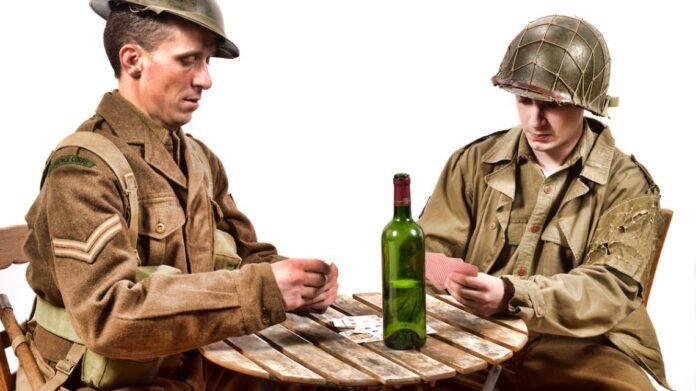Playing cards originated in 9th century China, spreading across Southeast Asia, the Middle East, and North Africa before making their way to Europe. From there, English and French colonialism inadvertently took them to Earth’s four corners. Although nobody knows the exact symbolism behind a modern deck’s configuration, some hypothesize the calendar inspired it.
After all, there are 52 cards in a deck and 52 weeks in a year. The 12 court cards may coincide with the 12 months, and 13 cards per suit suggest the 13 lunar cycles. Some say red and black cards symbolize day and night, and if you sum up the value of all the cards, you get 365!
But clandestine messages in playing cards took on a particular urgency during World War II. In fact, British and American intelligence utilized them to smuggle escape maps to POWs behind enemy lines.
The Best Christmas Gift a POW Could Hope For
In 1944, the United States Playing Card Company (USPCC) gifted American and British POWs with the perfect gift. Playing card decks with secret escape maps hidden inside. Prisoners only had to apply a little water to peel away the two sides of the card, revealing the maps inside.
The decks represented an impressive and unique collaboration between the USPCC, the American Office of Strategic Services, and the British Special Operations Executive agency. They provided prisoners with hope and an actionable plan to get out of Dodge.
Playing cards represented the ideal medium for escape maps for a couple of reasons. They had been a part of the battlefield since at least World War I. That’s when the USPCC began manufacturing them cheaply, guaranteeing accessibility to even the poorest soldiers.
The Ideal Medium for Secrecy
Why did playing cards prove so popular? Because being a soldier represented a game of hurry up and wait. Card games ultimately made the waiting part of that equation more bearable. Especially for POWs who spent days, months, and even years imprisoned with little else to do. For this reason, guards at camps didn’t think twice about dispersing playing cards to their charges.

Via Wikimedia Commons.
But unbeknownst to the guards, standard playing cards also lent themselves to hiding extra material due to their construction. Crafted from two layers of paper laminated and glued together, the USPCC found sandwiching micro-maps between those layers a cinch … and one that came with potentially lifesaving implications.
After all, life as a German POW was far from a party. Although the Nazis generally followed the rules of the Geneva Convention, brutal exceptions always existed. Moreover, rations proved insufficient, and enlisted men faced heavy labor, which could quickly wear them down, making escape nearly impossible. In other words, time proved of the essence.
Crooked Cellophane Gave Them Away
To ensure the micro-maps inside the playing decks remained concealed, the USPCC printed and distributed them along with legit decks. All the decks bore the Bicycle logo and came in boxes printed with elaborate blue and white designs. Crooked cellophane seals distinguished ones featuring secret cartography from their standard counterparts.
Historians also speculate that the USPCC printed regional variations of decks to help prisoners held in different locations. For example, POWs at Colditz Castle received a series of micro-maps to help them find their way through Saxony. All told, 48 of the cards contained various parts of a larger map that could be assembled by relying on the map key in the Joker cards. What’s more, the Aces held special information about map details like roads and rivers.
Beyond these basics, micro-maps also had information about electric cables and other infrastructure used for navigational purposes. And they also contained warnings about dangerous areas, hills where prisoners could get the best views, geographic features to follow, and more.
Santa Showed Up All Year Long
The most infamous drop of loaded playing cards to British and American POWs during World War II came in the form of 1944’s special Red Cross Christmas package. But this was by no means the only time “loaded cards” made their way overseas. In fact, receiving special deliveries from America and Great Britain proved a regular part of life behind bars.
Up to 100 care packages per day were sent from a temporary Army installation in Alexandria, Virginia, and many scholars believe these care packages included navigable card decks. Special deliveries also made their way from various addresses in London to prisons across Germany. Unfortunately, many of these addresses no longer exist due to wartime bombing.
But the best testament to the success of the maps comes from the prisoners. At least 32 POWs successfully fled Colditz Castle because of the maps, and 300 more tried. Andrew Hammond of the International Spy Museum has spent time studying this fascinating history. He notes that there are too many unknown variables to get a clear handle on how many card decks once existed or the number of escapes they aided. Today, only two original decks remain, both housed at the International Spy Museum in Washington, D.C. Bicycle has also released two commemorative reprints of the “Escape Map” cards, one in 1990 and a second in 2013.
By Engrid Barnett, contributor for Ripleys.com
EXPLORE THE ODD IN PERSON!
Hits: 0











